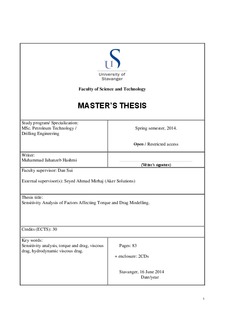| dc.contributor.author | Hashmi, Muhammad Jahanzeb | |
| dc.date.accessioned | 2014-12-18T10:15:00Z | |
| dc.date.available | 2014-12-18T10:15:00Z | |
| dc.date.issued | 2014-06-14 | |
| dc.identifier.uri | http://hdl.handle.net/11250/227754 | |
| dc.description | Master's thesis in Petroleum engineering | nb_NO |
| dc.description.abstract | As the modern day extended reached wells are getting longer and more complex, the torque and drag is one of the restraining aspects for achieving the target depth. Torque and drag becomes a precarious issue, for example it can be difficult to land the long completion string. Therefore, understanding the friction in the wellbore and how it affects hook load and torque is essential for well path design in planning phase as well as for real time monitoring analysis and post analysis. In planning phase the offset well torque and drag profiles will be used to better well planning. In real time monitoring the torque and drag roadmaps will be used as the well is drilling in order to warn us about upcoming potential drilling problems. In post analysis the torque and drag profiles will be analyzed in order to optimize the well path and drillstring design of new wells in the same area.
There are some confusion about torque and drag software and validity of models that are used to characterize drilling operation, especially as the well trajectory is getting more complex.
The objective of this study is to perform a sensitivity analysis on different parameters that affect torque and drag in drilling wellbores. The parameters that will be investigated in this project are those which are place of negotiation among individuals; in a way that some of them believe the effect of such parameters are negligible whereas some have opinion that effects of these parameters must be taken into account. These parameters are:
Extra friction due to sheave
Friction due to hydrodynamic viscous drag force
Effect of weight on bit (WOB) on torque
In order to carry out this study Landmark WellPlan software has been used. For the effect of viscous drag forces Kristian Gjesrstad’s medium-order flow model for dynamic pressure surges (Gjerstad, March 2013) was used to compare the results obtained from WellPlan. The Gjerstad’s model takes into account the effects of combined axial and rotational movement of pipe as well as the flow regimes. | nb_NO |
| dc.language.iso | eng | nb_NO |
| dc.publisher | University of Stavanger, Norway | nb_NO |
| dc.subject | sensitivity analysis | nb_NO |
| dc.subject | torque and drag | nb_NO |
| dc.subject | viscous drag | nb_NO |
| dc.subject | hydrodynamic viscous drag | nb_NO |
| dc.subject | petroleumsteknologi | nb_NO |
| dc.title | Sensitivity analysis of factors affecting torque and drag modelling | nb_NO |
| dc.type | Master thesis | nb_NO |
| dc.subject.nsi | VDP::Technology: 500::Rock and petroleum disciplines: 510::Petroleum engineering: 512 | nb_NO |
